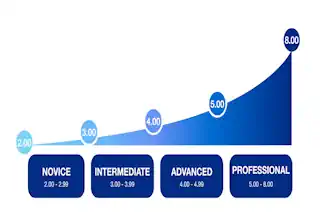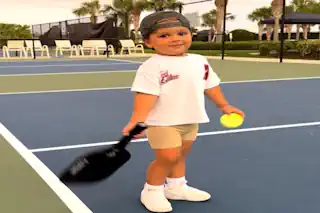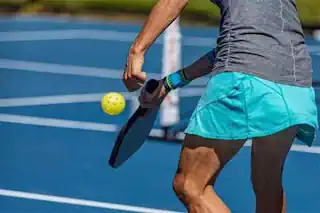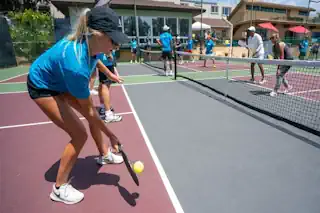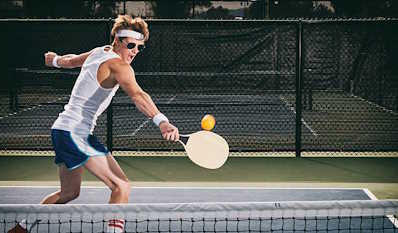Mastering Pickleball Agility: The Essential Guide to Four Square Pickleball Drills

Pickleball, the lively amalgamation of tennis, badminton, and table tennis, has swept through the sports scene with its exciting pace and accessibility. For pickleball enthusiasts looking to hone their agility, the Four Square Drill is an essential practice and one of the more advanced pickleball drills.
Whether you’re aiming to improve your reaction time, footwork, or consistency, mastering these drills can take your game to the next level. This instructional post will guide you through the setup, execution, and advanced tips for using Four Square Drills to your advantage.
If you do not yet play pickleball, you will find these drills and associated game play to be an innovative game that is fun all by itself. You can forget all of the regulation pickleball rules and just focus on the subset that is 4 square pickleball.
A Deeper Look at Four Square Pickleball Drills
The Four Square Drill is a dynamic way to improve your agility and strategy and is well-loved by coaches and players alike. The concept is straightforward; players are split into four squares, mimicking the setup of the game court’s non-volley zone or “kitchen.” Drills within these squares focus on different aspects of your game, such as smashing, backhand, forehand, and more. The structure allows for fast-paced, high-intensity training sessions that push players to their limits. Unlike pickleball wall drills, 4 is only four square game that blends player variety and shot control with strategy.
Why Practice Four Square Pickleball Drills?
The advantages of Four Square Drills are numerous. Through these practices, players can:
Enhance their agility and speed
Improve reaction times and positional accuracy
Develop better shot control and strategic thinking
Practice under pressure, simulating game conditions
Practice hitting very specific shots
Work on how much power is needed to complete certain shots
These benefits are invaluable for players at any level looking to progress in their pickleball journey. Now, it’s time to take a closer look at how to conduct these drills and what you can do to enhance the experience.
Setting Up the Court and Equipment
Before you grab your paddle and a partner, it’s important to set up your pickleball court and the necessary gear. The following steps will help prepare your environment for successful Four Square Drills.
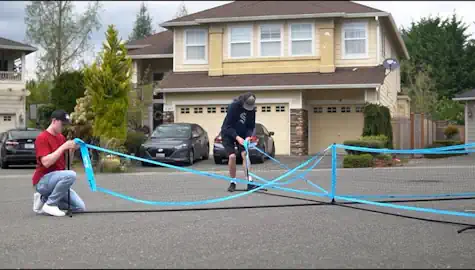
Court Setup
Choose a standard pickleball court or mark out a 20×44-foot area.
Divide the court into four equal squares using chalk or tape to mark boundaries. Each square should be roughly 10×22 feet.
Ensure each square is properly labeled or distinguished to avoid confusion during the drills.
The positioning should replicate the non-volley zone’s layout within a full pickleball court without a kitchen line.
Equipment Checklist
Pickleball paddles for each player
A sufficient number of pickleballs
A timer or smartphone with a countdown capability
Cones or markers to outline the squares
Proper footwear, ideally with non-marking soles for court protection and maneuverability
Now that the court and equipment are in order, it’s time to move into the heart of the practice.
The Four Square Pickleball Drills Breakdown
Four Square Drills are designed to isolate different skills for focused development. Each drill within a square will concentrate on various techniques and pickleball shots. Here’s how to structure your session for maximum benefit.
Basic Rally – Square One
The first square is dedicated to continuous play. The goal here is to ensure a consistent rally within the square without letting the ball bounce more than once. This drill focuses on hand-eye coordination, paddle control, and reaction times.
Players can practice various shots like dinking, lobs, and volleys.
The center of this square is a hot spot; players should aim to return to it after their shots for better transition and position.
Smashing – Square Two

In the second square, players focus on their smashing technique. One player lobs the ball and the other attempts to hit forehand and smash it down. This drill is perfect for improving your overhead strokes and timing which are essential pickleball skills.
The player who’s smashing must move quickly to the lobbied position to avoid letting the ball bounce twice.
Use proper footwork to position yourself correctly for the smash, and ensure a high-contact point for optimal shot selection.
Backhand Shots and Forehand Shots – Squares Three and Four
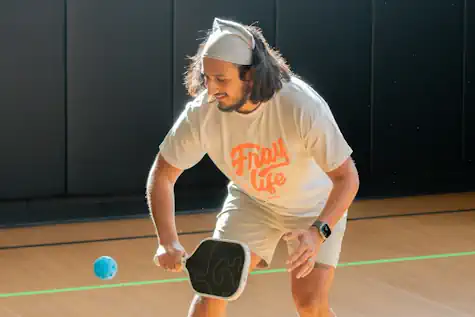
Squares three and four are dedicated to backhand and forehand drills, respectively. Here, players will practice their return shots, focusing on technique and control. This is where you work on your dinking game and drop shots. Plan for a third shot drop shot and a fourth shot dink shot.
Maintain a low stance and bend the knees to ease movement and generate power.
Your ‘ready’ position should face the net, with your body weight centered for quick movement in any direction.
Each drill should last for a set amount of time, with players rotating between squares to ensure a balanced workout and the development of various skills. A typical session may include several sets of 3-5 minutes in each square, with rest intervals between each for recovery.
Tips for Optimal Performance
Four Square Drills can be challenging, but effective. Here are some tips to help you make the most of your practice session:
Prioritize Technique Over Speed
Especially when you first tackle the drills, it’s essential to focus on your form. Proper technique will set the foundation for faster and more accurate plays down the line.
Communicate and Encourage
If you’re practicing with a partner or a group, good communication is key. Encourage each other and offer constructive feedback to foster a motivational and supportive environment.
Vary the Intensity
While consistency is important, don’t be afraid to ramp up the intensity with a few fast rallies to challenge your reflexes. This variability will simulate real game conditions and prepare you for faster-paced matches.
Visualize Game Scenarios
Try to imagine realistic game scenarios as you play. Visualizing opponents and tactics can make the drills more effective for strategic development.
Stay Hydrated and Rest Well
Agility drills can be quite demanding, so ensure that you’re properly hydrated, and don’t overlook the value of rest. Adequate recovery time is essential for muscle repair and overall performance improvement.
Four Square Game Application
After diligently working through complete set of Four Square Drills, applying these skills in an actual Four Square game scenario becomes the next step. This section of practice is designed to integrate isolation drills into dynamic gameplay, bridging the gap between drill precision and competitive application.
The Game Setup
Use the same court setup as for the drills, with the court divided into four equal squares, or buy a four square pickleball net designed specifically for this type of game play.
Determine the order of players who will rotate through the squares, with the objective to advance to the first square and maintaining that position. You can have as many players as you like play in this version of a pickleball game.

The Rules
The player in the highest square serves the ball diagonally into the opposite corner.
Each player must return the ball into another square after a single bounce in their own square.
If a player fails to return the ball or it lands out of bounds, they move to the lowest square, causing other players to advance.
All hits must be underhand only.
The game continues until one player dominates the one position for more than 4 rounds of play.
Objectives and Outcomes
This game enhances tactical thinking as players decide which square to target to challenge their opponent’s weaknesses. Strategically thinking about the next shot improves response and anticipation during a regulation pickleball game.
Improve body position even during casual play.
Encourages the application of specific skills practiced in isolation, such as precision in the backhand and forehand drills or effective smashing.
Aids in developing a competitive mindset while maintaining focus on skill refinement.
Shorten the learning curve by presenting a greater variety of shot options and opponents.
Incorporation with Drills
Integrating Four Square games into the practice session should follow a comprehensive drill workout. This allows players to apply the drilled skills under competitive conditions, enhancing muscle memory and decision-making under pressure. Sessions can conclude with several rounds of the game, providing a fun and challenging end to a rigorous practice.
Conclusion and Future Practice
The Four Square Drills represent an extraordinary chance to transform your pickleball performance. By diligently practicing these drills, you will not only enhance your agility and skill but also cultivate a competitive edge.
Remember, consistency in practice will yield the best results. Each session is an opportunity to improve, so devote yourself fully to the drills and watch as your game evolves. Whether you’re a baseline player or one of the advanced players, these drills will keep your skills sharp and your spirit strong.
Frequently Asked Questions (FAQ)
How often should I practice 4 Square Drills?
To see a significant improvement, it’s recommended that you engage in these simple drills at least 2-3 times a week. However, listen to your body and allow for proper rest and recovery to prevent injuries.
Can these drills be performed alone?
While most of the drills are designed for pairs or groups to simulate game-like scenarios, you can adapt several drills to practice alone by using a wall or a rebound net.
What equipment is necessary for 4 Square Drills?
The essential equipment includes a regulation pickleball net, a minimum of four wood pickleball paddles, and a court marked into four equal squares. Additional helpful gear might include cones for more precise court division and a portable 4 square net if a standard court isn’t available.
How do I know if I’m performing the drills correctly?
Focus on form and technique rather than speed, especially initially. Recording yourself can provide visual feedback, or practicing with a coach or experienced player can offer more immediate corrective advice. The best pickleball drills are the ones you enjoy and recognize your game improving because of them.
Is there a specific order I should follow when practicing these drills?
While there’s no strict order, it’s beneficial to start with pickleball drills that focus on movement and agility before moving on to more skill-specific drills like smashing and precision shots. This helps warm up the body and improve overall performance.
How can I measure my progress?
Tracking progress can involve noting improvements in specific skills, such as increased accuracy or power in shots, or general enhancements like better stamina or quicker recovery times. Keeping a practice log can also help in monitoring advancements over time.
What if I don’t have four players to practice the 4 Square Game?
You can modify the game for three or even two players by adjusting the rules and court size. The objective remains the same, to improve your skills and apply them in a dynamic, game-like scenario.
Can these drills be used for other racket sports?
Absolutely! While tailored for pickleball, the core principles of agility, precision, technique, and tactical thinking are applicable across various racket sports, including tennis and badminton. Adjustments may be needed to accommodate different court sizes and rules.
